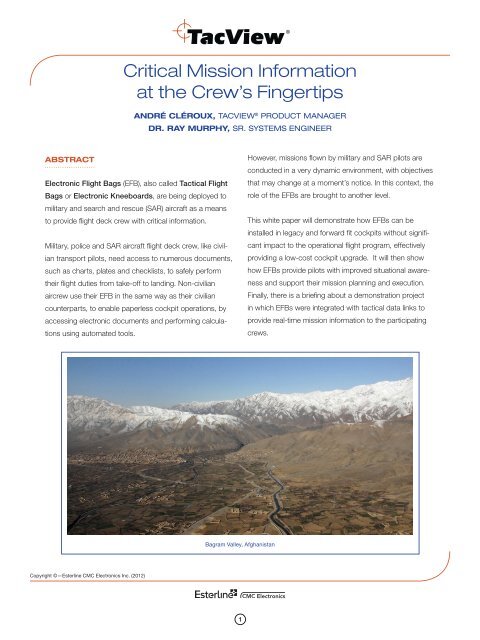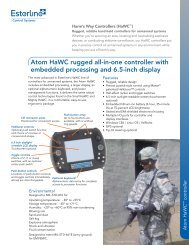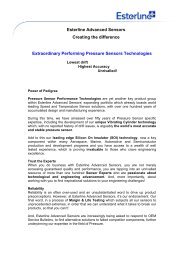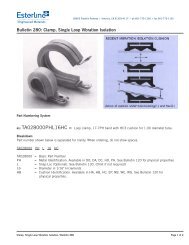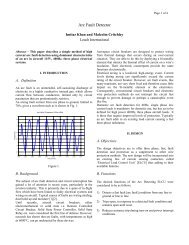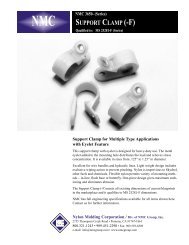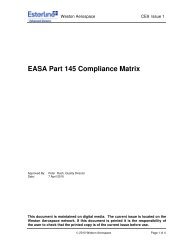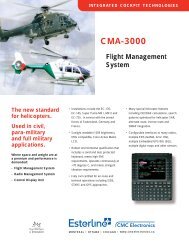Critical Mission Information at the Crew's Fingertips - Esterline
Critical Mission Information at the Crew's Fingertips - Esterline
Critical Mission Information at the Crew's Fingertips - Esterline
Create successful ePaper yourself
Turn your PDF publications into a flip-book with our unique Google optimized e-Paper software.
<strong>Critical</strong> <strong>Mission</strong> <strong>Inform<strong>at</strong>ion</strong><br />
<strong>at</strong> <strong>the</strong> Crew’s <strong>Fingertips</strong><br />
ANDRÉ CLÉROUX, TACVIEW ® PRODUCT MANAGER<br />
DR. RAY MURPHY, SR. SYSTEMS ENGINEER<br />
ABSTRACT<br />
Electronic Flight Bags (EFB), also called Tactical Flight<br />
Bags or Electronic Kneeboards, are being deployed to<br />
military and search and rescue (SAR) aircraft as a means<br />
to provide flight deck crew with critical inform<strong>at</strong>ion.<br />
Military, police and SAR aircraft flight deck crew, like civilian<br />
transport pilots, need access to numerous documents,<br />
such as charts, pl<strong>at</strong>es and checklists, to safely perform<br />
<strong>the</strong>ir flight duties from take-off to landing. Non-civilian<br />
aircrew use <strong>the</strong>ir EFB in <strong>the</strong> same way as <strong>the</strong>ir civilian<br />
counterparts, to enable paperless cockpit oper<strong>at</strong>ions, by<br />
accessing electronic documents and performing calcul<strong>at</strong>ions<br />
using autom<strong>at</strong>ed tools.<br />
However, missions flown by military and SAR pilots are<br />
conducted in a very dynamic environment, with objectives<br />
th<strong>at</strong> may change <strong>at</strong> a moment’s notice. In this context, <strong>the</strong><br />
role of <strong>the</strong> EFBs are brought to ano<strong>the</strong>r level.<br />
This white paper will demonstr<strong>at</strong>e how EFBs can be<br />
installed in legacy and forward fit cockpits without significant<br />
impact to <strong>the</strong> oper<strong>at</strong>ional flight program, effectively<br />
providing a low-cost cockpit upgrade. It will <strong>the</strong>n show<br />
how EFBs provide pilots with improved situ<strong>at</strong>ional awareness<br />
and support <strong>the</strong>ir mission planning and execution.<br />
Finally, <strong>the</strong>re is a briefing about a demonstr<strong>at</strong>ion project<br />
in which EFBs were integr<strong>at</strong>ed with tactical d<strong>at</strong>a links to<br />
provide real-time mission inform<strong>at</strong>ion to <strong>the</strong> particip<strong>at</strong>ing<br />
crews.<br />
Bagram Valley, Afghanistan<br />
Copyright ©—<strong>Esterline</strong> CMC Electronics Inc. (2012)<br />
1
<strong>Critical</strong> <strong>Mission</strong> <strong>Inform<strong>at</strong>ion</strong> <strong>at</strong> <strong>the</strong> Crew’s <strong>Fingertips</strong><br />
INTRODUCTION<br />
It’s 0400 hours and <strong>the</strong> order to commence a comb<strong>at</strong><br />
search and rescue (CSAR) oper<strong>at</strong>ion has been relayed to<br />
your base. A short while earlier, an F-16 Falcon aircraft<br />
crashed after reportedly losing power, and it has not been<br />
heard from since. It went missing in a mountainous region<br />
approxim<strong>at</strong>ely 40 km North of Kandahar Air Base (KDH).<br />
The CSAR mission is quickly disp<strong>at</strong>ched from KDH.<br />
It includes armed and heavy lift helicopters, two C-130<br />
Hercules tactical transport and one tanker. The mission is<br />
receiving additional support from a USAF E-3 AWACS aircraft<br />
th<strong>at</strong> has been orbiting in support of o<strong>the</strong>r oper<strong>at</strong>ions<br />
ano<strong>the</strong>r 200 km to <strong>the</strong> east of <strong>the</strong> probable crash site.<br />
It is a cold winter morning. At <strong>the</strong> crack of dawn, <strong>the</strong><br />
mission is airborne before any additional inform<strong>at</strong>ion about<br />
<strong>the</strong> missing aircraft has become available. The crews<br />
must quickly reach <strong>the</strong>ir objective while avoiding hostile<br />
install<strong>at</strong>ions along <strong>the</strong> way.<br />
How can <strong>the</strong> downed crew be extracted quickly and<br />
without putting <strong>the</strong> rescue team <strong>at</strong> risk<br />
From military oper<strong>at</strong>ions in Afghanistan and Libya to disaster<br />
relief efforts in Thailand and Haiti, air forces around<br />
<strong>the</strong> world, required to oper<strong>at</strong>e toge<strong>the</strong>r, are faced with <strong>the</strong><br />
short-term requirement for real-time situ<strong>at</strong>ional awareness<br />
and improved intra-<strong>the</strong><strong>at</strong>re communic<strong>at</strong>ions. This is where<br />
TacView has been playing a role th<strong>at</strong> goes beyond wh<strong>at</strong><br />
Electronic Flight Bags are usually used for. In <strong>the</strong> second<br />
part of this white paper, we will discuss how an EFB<br />
can improve mission effectiveness by providing real-time,<br />
mission critical inform<strong>at</strong>ion to <strong>the</strong> pilots. But first, we will<br />
address how EFBs can be installed with negligible impact<br />
to aircraft systems and minimal investment.<br />
CMC ELECTRONIC’S<br />
TACVIEW:<br />
THE MISSION ENABLER<br />
The TacView Portable <strong>Mission</strong> Display<br />
is an Intel ® based, Microsoft ® Windows<br />
oper<strong>at</strong>ing system comp<strong>at</strong>ible display designed<br />
for airborne oper<strong>at</strong>ion. Its powerful<br />
processing capabilities, high resolution<br />
sunlight readable and NVIS comp<strong>at</strong>ible<br />
display enable it to support mission<br />
execution with a flexibility brought by<br />
no o<strong>the</strong>r airborne mission computer.<br />
A separ<strong>at</strong>e aircraft power/d<strong>at</strong>a interface<br />
unit, called <strong>the</strong> Expansion Module Unit,<br />
provides conditioned aircraft power to <strong>the</strong><br />
PMD, as well as functional connectivity to<br />
o<strong>the</strong>r airborne systems through dedic<strong>at</strong>ed<br />
aircraft d<strong>at</strong>a and signal interfaces. A custom<br />
cable allows for high bandwidth connectivity<br />
between <strong>the</strong> 2 LRUs and offers a<br />
hot-pluggable l<strong>at</strong>ching mount to allow PMD<br />
docking and undocking while active. This<br />
m<strong>at</strong>ing system is designed to interface with<br />
a large selection of off-<strong>the</strong>-shelf mounting<br />
hardware, allowing for install<strong>at</strong>ion across<br />
a wide range of aircraft configur<strong>at</strong>ions.<br />
Portable <strong>Mission</strong> Display<br />
Copyright ©—<strong>Esterline</strong> CMC Electronics Inc. (2012)<br />
2
<strong>Critical</strong> <strong>Mission</strong> <strong>Inform<strong>at</strong>ion</strong> <strong>at</strong> <strong>the</strong> Crew’s <strong>Fingertips</strong><br />
EFB SELECTION AND INSTALLATION<br />
EFBs have been around for more than 15 years. They<br />
were first introduced in <strong>the</strong> cockpit as laptops running<br />
word processing and spreadsheet applic<strong>at</strong>ions, but were<br />
closely followed by dedic<strong>at</strong>ed devices. Northstar, a division<br />
of CMC Electronics, was one of <strong>the</strong> first companies<br />
to launch a dedic<strong>at</strong>ed EFB device, <strong>the</strong> CT-1000, in <strong>the</strong><br />
second half of <strong>the</strong> 90’s. This was targeted to business<br />
jet owners and oper<strong>at</strong>ors as well as <strong>the</strong> general avi<strong>at</strong>ion<br />
market.<br />
HOW DO EFBs HELP THE MILITARY<br />
PILOT<br />
Paperless cockpit<br />
Reducing reliance on paper is <strong>the</strong> genesis of <strong>the</strong> EFB<br />
system, and differs mainly by <strong>the</strong> type of oper<strong>at</strong>ional<br />
documents required in military-type oper<strong>at</strong>ions. Thus, <strong>the</strong><br />
EFB system must be able to store and display checklists,<br />
approach pl<strong>at</strong>es, charts, flight and maintenance manuals,<br />
special oper<strong>at</strong>ing procedures, foreign clearance guides,<br />
etc. Weight and Balance (W&B) and Take-Off and Landing<br />
(TOLD) calcul<strong>at</strong>ions are applic<strong>at</strong>ions th<strong>at</strong> are gaining<br />
ground. These tools will improve mission effectiveness by<br />
allowing quicker, yet safer departures.<br />
At first glance, this requirement can be met by any electronic<br />
device available on <strong>the</strong> market today. However, <strong>the</strong><br />
device must be installed in a design<strong>at</strong>ed cockpit loc<strong>at</strong>ion,<br />
to be used especially during strong acceler<strong>at</strong>ions, such as<br />
those in take-off, landing and turbulence. Fur<strong>the</strong>rmore, in<br />
many cases, <strong>the</strong> EFB must be Night Vision Imaging System<br />
(NVIS) comp<strong>at</strong>ible, and it has to permit gloved hand<br />
oper<strong>at</strong>ions which can be problem<strong>at</strong>ic with some types of<br />
touchsreens.<br />
<strong>Mission</strong> planning<br />
Military pilots must spend <strong>the</strong> majority of <strong>the</strong>ir efforts determining<br />
<strong>the</strong> best way to effectively employ <strong>the</strong>ir aircraft<br />
while decreasing <strong>the</strong>ir thre<strong>at</strong> vulnerability.<br />
In most EFB retrofit install<strong>at</strong>ions, <strong>the</strong> EFB device provides<br />
a digital map applic<strong>at</strong>ion with terrain elev<strong>at</strong>ion inform<strong>at</strong>ion<br />
showing <strong>the</strong> pre-planned flight p<strong>at</strong>h. The digital<br />
map applic<strong>at</strong>ion must be comp<strong>at</strong>ible with <strong>the</strong> mission<br />
planning system in use by <strong>the</strong> air force, in order for both<br />
systems to exchange d<strong>at</strong>a files containing <strong>the</strong> flight plan<br />
and o<strong>the</strong>r inform<strong>at</strong>ion rel<strong>at</strong>ed to friendly or enemy topics.<br />
<strong>Mission</strong> planning systems, such as <strong>the</strong> USAF Portable<br />
Flight Planning System (PFPS), are designed for a desktop<br />
PC environment running Microsoft Windows ® . The digital<br />
map derived from PFPS is called FalconView , and also<br />
oper<strong>at</strong>es on Windows. When FalconView is fed in real<br />
time with aircraft position, altitude and heading (normally<br />
provided by a GPS receiver), it will display an oriented<br />
aircraft icon as an overlay <strong>at</strong> <strong>the</strong> proper geo-referenced<br />
loc<strong>at</strong>ion on <strong>the</strong> map.<br />
Military tactical oper<strong>at</strong>ions are extremely demanding on<br />
<strong>the</strong> crew, as <strong>the</strong>y perform <strong>the</strong>ir tasks in a high workload<br />
environment. Being able to quickly assess one’s current<br />
loc<strong>at</strong>ion with respect to <strong>the</strong> planned route improves mission<br />
effectiveness and survivability. While a Windowsbased<br />
applic<strong>at</strong>ion should not be used for actual navig<strong>at</strong>ion,<br />
<strong>the</strong> EFB digital map applic<strong>at</strong>ion provides a distinct<br />
real benefit in terms of situ<strong>at</strong>ional awareness.<br />
Real Time <strong>Inform<strong>at</strong>ion</strong> in <strong>the</strong> Cockpit<br />
Knowledge of <strong>the</strong> surroundings is critical to decision-making<br />
in complex, dynamic environments. Situ<strong>at</strong>ional awareness<br />
means being aware of wh<strong>at</strong> is happening around<br />
us, so we can shape our actions to meet our goals and<br />
objectives, both immedi<strong>at</strong>ely and in <strong>the</strong> near future.<br />
Copyright ©—<strong>Esterline</strong> CMC Electronics Inc. (2012)<br />
3
<strong>Critical</strong> <strong>Mission</strong> <strong>Inform<strong>at</strong>ion</strong> <strong>at</strong> <strong>the</strong> Crew’s <strong>Fingertips</strong><br />
When connected to a tactical network via <strong>the</strong> aircraft<br />
radio or s<strong>at</strong>ellite communic<strong>at</strong>ion system, <strong>the</strong> EFB suddenly<br />
becomes a mission computer th<strong>at</strong> can provide real-time<br />
inform<strong>at</strong>ion on friendly assets, thre<strong>at</strong>s and o<strong>the</strong>r types of<br />
intelligence. This inform<strong>at</strong>ion can be placed in a graphic<br />
layer over <strong>the</strong> digital map applic<strong>at</strong>ion, adding to <strong>the</strong> benefits<br />
of <strong>the</strong> EFB system.<br />
The availability of a tactical d<strong>at</strong>a link makes text messaging<br />
available, allows crews to freely obtain more inform<strong>at</strong>ion<br />
on assets or thre<strong>at</strong>s in <strong>the</strong>ir vicinity, and simplifies<br />
command and control tasks. The use of a standardized<br />
tactical d<strong>at</strong>a link, such as Link 16, also enables multin<strong>at</strong>ional<br />
cooper<strong>at</strong>ion.<br />
To achieve real-time inform<strong>at</strong>ion in <strong>the</strong> cockpit, <strong>the</strong> EFB<br />
system should efficiently interface with <strong>the</strong> aircraft avionics<br />
buses to obtain a number of parameters th<strong>at</strong> are<br />
required to support <strong>the</strong> moving map applic<strong>at</strong>ion, as well<br />
as support <strong>the</strong> outbound transmission of inform<strong>at</strong>ion th<strong>at</strong><br />
must be sent to o<strong>the</strong>rs via <strong>the</strong> airborne network. It also<br />
requires <strong>the</strong> EFB to interface to <strong>the</strong> communic<strong>at</strong>ion equipment<br />
available on-board <strong>the</strong> aircraft. Because <strong>the</strong> tactical<br />
d<strong>at</strong>a links are classified, <strong>the</strong> EFB hardware must meet <strong>the</strong><br />
<strong>Inform<strong>at</strong>ion</strong> Assurance requirements and provide a means<br />
for declassific<strong>at</strong>ion.<br />
KEYS TO FIT THE MISSION<br />
EFBs can be installed in legacy and forward fit cockpits.<br />
To meet <strong>the</strong>ir promise of providing a low cost cockpit upgrade,<br />
oper<strong>at</strong>ors need to consider <strong>the</strong> following key selection<br />
requirements.<br />
Hardware Characteristics<br />
• Size — While large screen displays are desirable, cockpit<br />
real-est<strong>at</strong>e is extremely limited, and <strong>the</strong> EFB display<br />
size should be as compact as possible. Limited real<br />
est<strong>at</strong>e is not just applicable to display space, it applies<br />
to all o<strong>the</strong>r EFB system components such as <strong>the</strong> aircraft<br />
interface units. Small size generally transl<strong>at</strong>es into smaller<br />
weight, which facilit<strong>at</strong>es install<strong>at</strong>ion.<br />
• Portability — From a hardware perspective, portable<br />
EFBs have a leg up over permanent install<strong>at</strong>ions. Portable<br />
EFBs can be issued to every pilot, allowing <strong>the</strong>m to develop<br />
a high level of familiarity with <strong>the</strong>ir tools, stored documents<br />
and <strong>the</strong> way to access <strong>the</strong>m. Crews can plan <strong>the</strong>ir<br />
mission immedi<strong>at</strong>ely as <strong>the</strong>y exit <strong>the</strong> briefing room, and<br />
upd<strong>at</strong>e it on <strong>the</strong> flight line as more inform<strong>at</strong>ion on <strong>the</strong> mission<br />
is made available to <strong>the</strong>m. For example, a portable<br />
EFB can be used for mission planning even if <strong>the</strong> crew, for<br />
unforeseen reasons, is diverted to ano<strong>the</strong>r base.<br />
The TacView Portable <strong>Mission</strong> Display (PMD) is being<br />
deployed with this capability as part of <strong>the</strong> US Air N<strong>at</strong>ional<br />
Guard C-130H Real Time <strong>Inform<strong>at</strong>ion</strong> in <strong>the</strong> Cockpit program,<br />
<strong>the</strong> USAF C-130J and C-17 Mobility Air Force Dynamic<br />
Re-tasking Capability (MAF DRC) program, and on<br />
<strong>the</strong> US Coast Guard MH-65 used in air interdiction roles.<br />
• Mount — In a cockpit retrofit applic<strong>at</strong>ion, <strong>the</strong> biggest<br />
challenge is to identify a mount loc<strong>at</strong>ion th<strong>at</strong> will allow<br />
<strong>the</strong> use of <strong>the</strong> EFB without hindering visibility to standby<br />
instruments, <strong>the</strong> primary flight display and navig<strong>at</strong>ion/multifunction<br />
displays. The mount loc<strong>at</strong>ion should be as close<br />
as possible to <strong>the</strong> primary field of view. Fur<strong>the</strong>rmore, <strong>the</strong><br />
EFB install<strong>at</strong>ion must not obstruct egress p<strong>at</strong>hs, such as<br />
window escape, and it must not impede access and handling<br />
of key controls. For <strong>the</strong> oper<strong>at</strong>or, higher savings will<br />
accrue if one EFB system can be used across a wide fleet<br />
Copyright ©—<strong>Esterline</strong> CMC Electronics Inc. (2012)<br />
4
<strong>Critical</strong> <strong>Mission</strong> <strong>Inform<strong>at</strong>ion</strong> <strong>at</strong> <strong>the</strong> Crew’s <strong>Fingertips</strong><br />
of diverse aircraft, due to <strong>the</strong> reduction in training and support<br />
costs, which requires <strong>the</strong> selection of an EFB system<br />
with a variety of mounting options.<br />
For example, mount solutions allow <strong>the</strong> TacView Portable<br />
<strong>Mission</strong> Display to be installed on side panels, front<br />
panels, yokes, and standard Dzus mounting rails. Where<br />
aircraft mounting is impossible, such as on <strong>the</strong> US Coast<br />
Guard MH-65 Dolphin helicopter, a kneeboard solution is<br />
available.<br />
• D<strong>at</strong>a Interfaces — The objective of a low-cost EFB network<br />
integr<strong>at</strong>ion is to get as much d<strong>at</strong>a as possible from<br />
<strong>the</strong> existing aircraft avionics and sensors, without impacting<br />
<strong>the</strong> oper<strong>at</strong>ional flight program. The software contained<br />
in <strong>the</strong> navig<strong>at</strong>ion, flight or weapons management systems<br />
should be essentially untouched. From a hardware perspective,<br />
this means th<strong>at</strong> <strong>the</strong> EFB should provide a wide<br />
array of interfaces to receive d<strong>at</strong>a from <strong>the</strong> avionics busses,<br />
electro-optical/infrared (EO/IR) sensor and o<strong>the</strong>r key<br />
aircraft sub-systems without disrupting <strong>the</strong> bus integrity<br />
even in case of EFB failure. It should also be capable of<br />
interfacing with <strong>the</strong> on-board radios or communic<strong>at</strong>ion<br />
terminals and E<strong>the</strong>rnet networks. The aircraft interface<br />
unit should also provide space for growth as user needs<br />
typically grow in <strong>the</strong> years following <strong>the</strong> initial fielding of <strong>the</strong><br />
equipment.<br />
• User Interface — As an inform<strong>at</strong>ion management<br />
device, one cannot overlook <strong>the</strong> EFB user interfaces. The<br />
availability of backlit line select keys around <strong>the</strong> display<br />
allows <strong>the</strong> pilots to select menu options in all flight conditions,<br />
including high dynamic manoeuvres and turbulence.<br />
In <strong>the</strong> same manner, a distinct and backlit keyboard with<br />
tactile feedback will provide pilots with a trustworthy interface<br />
and can be used with gloved hands to speed up d<strong>at</strong>a<br />
entry and text messaging. A touchscreen interface will<br />
also provide flexibility when interacting with applic<strong>at</strong>ions in<br />
non-critical flight conditions.<br />
Display readability under all lighting conditions is essential.<br />
Sunlight readability must be measured by contrast r<strong>at</strong>io<br />
measured under full sunlight conditions. An integr<strong>at</strong>ed<br />
NVIS comp<strong>at</strong>ible display will provide a seamless integr<strong>at</strong>ion<br />
with o<strong>the</strong>r cockpit equipment. It is true th<strong>at</strong> NVIS film<br />
overlays do exist to convert PEDs into night vision goggle<br />
comp<strong>at</strong>ible devices, but <strong>the</strong>se require handling, can be<br />
lost, and normal wear will degrade display readability over<br />
time.<br />
O<strong>the</strong>r consider<strong>at</strong>ions<br />
• Obsolescence — Personal Electronic Devices rapidly<br />
evolve, and usually within a year’s time <strong>the</strong> previous model<br />
has become obsolete and is no longer being sold. This<br />
presents a very difficult problem to <strong>the</strong> avi<strong>at</strong>ion community<br />
working to keep systems standardized across <strong>the</strong> fleet<br />
and properly configured with mission software. The selection<br />
of an avi<strong>at</strong>ion grade product such as TacView gre<strong>at</strong>ly<br />
mitig<strong>at</strong>es this obsolescence issue, as it has a designed life<br />
of 10 years or more. With supported repair capability and<br />
<strong>the</strong> ability to upgrade <strong>the</strong> product <strong>at</strong> a very cost-effective<br />
price, such a system provides a solid solution to ensure<br />
a standardized system for an entire Air Force fleet while<br />
reducing total lifecycle costs.<br />
• Standardized, open architecture — The use of a Microsoft<br />
Windows oper<strong>at</strong>ing system allows user customiz<strong>at</strong>ion,<br />
while products th<strong>at</strong> are widely adopted by oper<strong>at</strong>ors<br />
and military forces provide <strong>the</strong> assurance th<strong>at</strong> applic<strong>at</strong>ions<br />
will be developed to enhance users’ oper<strong>at</strong>ions.<br />
Copyright ©—<strong>Esterline</strong> CMC Electronics Inc. (2012)<br />
5
<strong>Critical</strong> <strong>Mission</strong> <strong>Inform<strong>at</strong>ion</strong> <strong>at</strong> <strong>the</strong> Crew’s <strong>Fingertips</strong><br />
FOR THE MILITARY PILOT, A DIFFERENT<br />
REGULATORY ENVIRONMENT<br />
power and installed in a mounting device for use during<br />
normal aircraft oper<strong>at</strong>ion (from take-off to landing). Class<br />
2 EFBs can interface with o<strong>the</strong>r aircraft sub-systems, allowing<br />
<strong>the</strong>m to run applic<strong>at</strong>ions requiring inputs such as<br />
real-time aircraft position, video camera feeds or network<br />
connections to a s<strong>at</strong>ellite communic<strong>at</strong>ion system. Their<br />
associ<strong>at</strong>ed applic<strong>at</strong>ions are design<strong>at</strong>ed Type B. However,<br />
according to <strong>the</strong> FAA, a Class 2 EFB cannot display <strong>the</strong><br />
aircraft’s own ship position, except on an airport moving<br />
map .<br />
Because early EFB adopters oper<strong>at</strong>ed aircraft in controlled<br />
airspace, civil avi<strong>at</strong>ion authorities issued regul<strong>at</strong>ions to<br />
provide guidance on <strong>the</strong> certific<strong>at</strong>ion, airworthiness and<br />
oper<strong>at</strong>ional approval of EFB systems. The vocabulary<br />
developed under <strong>the</strong>se regul<strong>at</strong>ions is widely used today,<br />
and in some cases poses challenges to those not required<br />
to abide by civil avi<strong>at</strong>ion airworthiness standards.<br />
Under <strong>the</strong>se regul<strong>at</strong>ions, such as <strong>the</strong> Federal Avi<strong>at</strong>ion<br />
Administr<strong>at</strong>ion (FAA) Advisory Circular 120-76A, EFB<br />
hardware is defined in three “Classes”, with capabilities to<br />
oper<strong>at</strong>e one to three “Types” of applic<strong>at</strong>ion:<br />
• Class 1 devices are known as “Personal Electronic<br />
Devices” (PED), and can be anything from a laptop to a<br />
tablet, a personal digital assistant or smart phone. PEDs<br />
are usually mass-produced devices th<strong>at</strong> are not permanently<br />
mounted and not connected to <strong>the</strong> aircraft. These<br />
devices are allowed to oper<strong>at</strong>e Type A applic<strong>at</strong>ions, which<br />
are st<strong>at</strong>ic in n<strong>at</strong>ure. An example would be an applic<strong>at</strong>ion<br />
for displaying documents. Class 1 devices must be<br />
stowed during take-off and landing.<br />
• Class 2 devices can be PED or electronic equipment<br />
specifically designed for airborne use. These devices are<br />
portable, and <strong>the</strong>y will normally be connected to aircraft<br />
• Class 3 devices are permanently installed equipment<br />
th<strong>at</strong> must be maintained under strict avionics hardware<br />
and software design control. In general, but not always,<br />
<strong>the</strong>se devices are designed with an oper<strong>at</strong>ing system and<br />
a suite of applic<strong>at</strong>ions capable of meeting higher design<br />
assurance levels than commercial-off-<strong>the</strong>-shelf systems,<br />
and may be integr<strong>at</strong>ed with o<strong>the</strong>r airborne equipment and<br />
<strong>the</strong> aircraft oper<strong>at</strong>ional flight program. Such a Class 3<br />
EFB can be used, for example, as a Multi-Function Display,<br />
and it can present inform<strong>at</strong>ion th<strong>at</strong> can be used by<br />
<strong>the</strong> aircrew for navig<strong>at</strong>ion. Specifically, it can display <strong>the</strong><br />
aircraft’s own ship position on a chart.<br />
In <strong>the</strong> context of military, paramilitary and search and<br />
rescue oper<strong>at</strong>ions, an EFB is not limited to “Flight Bag”<br />
enhancement functionalities. Viewed in a broad context,<br />
an EFB is a computing device (hardware), designed to execute<br />
one or many computer programs (software), in order<br />
to provide benefits to <strong>the</strong> pilot. Said differently, an EFB is<br />
a <strong>Mission</strong> Computer (MC) with a display, and this is exactly<br />
why <strong>the</strong> TacView is called a “Portable <strong>Mission</strong> Display”.<br />
With <strong>the</strong> aim of ensuring air safety, <strong>the</strong> hardware install<strong>at</strong>ion<br />
requirements should be similar to those of comparable<br />
hardware devices installed on <strong>the</strong> aircraft. Thus,<br />
<strong>the</strong> EFB must meet <strong>the</strong> environmental requirements it<br />
is meant to oper<strong>at</strong>e in, must not interfere with o<strong>the</strong>r onboard<br />
equipment, and its install<strong>at</strong>ion must not impact<br />
Copyright ©—<strong>Esterline</strong> CMC Electronics Inc. (2012)<br />
6
<strong>Critical</strong> <strong>Mission</strong> <strong>Inform<strong>at</strong>ion</strong> <strong>at</strong> <strong>the</strong> Crew’s <strong>Fingertips</strong><br />
aircraft integrity and crew safety. This explains <strong>the</strong> very<br />
low cost of Class 1 equipment when compared with <strong>the</strong><br />
extremely high cost of Class 3 equipment procurement<br />
and integr<strong>at</strong>ion.<br />
Civil avi<strong>at</strong>ion certific<strong>at</strong>ion rules regarding software approvals<br />
are not adapted to military and paramilitary oper<strong>at</strong>ions.<br />
Military pilots oper<strong>at</strong>e in difficult mission environments<br />
where <strong>the</strong> presence of thre<strong>at</strong>s, obstacles and a<br />
quickly-evolving tactical situ<strong>at</strong>ion increase <strong>the</strong>ir workload<br />
and act to reduce <strong>the</strong>ir mission effectiveness. <strong>Mission</strong><br />
planning and tactical d<strong>at</strong>a link software applic<strong>at</strong>ions facilit<strong>at</strong>e<br />
critical inform<strong>at</strong>ion processing by pilots, so th<strong>at</strong> <strong>the</strong>y<br />
can achieve mission success and reduce <strong>the</strong>ir exposure<br />
to very real thre<strong>at</strong>s. The military needs to recognize <strong>the</strong><br />
value of using <strong>the</strong>se applic<strong>at</strong>ions th<strong>at</strong> have been thoroughly<br />
tested, but are not developed to design assurance<br />
levels typical for avi<strong>at</strong>ion systems. The US Air Force<br />
(USAF) did so, and allowed <strong>the</strong> use of digital maps with<br />
<strong>the</strong> own ship inform<strong>at</strong>ion as a situ<strong>at</strong>ional awareness aid.<br />
Taking exception to civil avi<strong>at</strong>ion certific<strong>at</strong>ion requirements<br />
is possible because air forces perform <strong>the</strong>ir own aircraft<br />
and system airworthiness approval.<br />
From <strong>the</strong> standpoint of <strong>the</strong> EFB equipment classes<br />
listed above, <strong>the</strong> TacView falls into its own special c<strong>at</strong>egory.<br />
From a cost and heritage point of view, it is a Class<br />
2 device, but based on its special hardware-level design<br />
upgrades, ruggedizing and qualific<strong>at</strong>ion, it is closer to a<br />
Class 3 device. At CMC, we <strong>the</strong>refore like to consider <strong>the</strong><br />
TacView as a very affordable “Class 2.5” EFB especially<br />
suited for military and para-military avi<strong>at</strong>ion.<br />
SUCCESSFUL<br />
NETWORKING WITH<br />
L-3 C2S2’S JET<br />
Network-centric oper<strong>at</strong>ion seeks to transl<strong>at</strong>e<br />
an inform<strong>at</strong>ion advantage into a competitive<br />
advantage through <strong>the</strong> robust networking<br />
of geographically dispersed forces. During<br />
CWID and CWIX 2011, L-3 Communic<strong>at</strong>ions<br />
Command and Control Systems & Software<br />
(C2S2) Division JET was <strong>the</strong> cornerstone applic<strong>at</strong>ion<br />
to enable such capability. L-3 Services’<br />
JET – or JRE Enabled TacView - combines<br />
two powerful applic<strong>at</strong>ions toge<strong>the</strong>r.<br />
At <strong>the</strong> core is L-3’s Joint Range Extension<br />
(JRE), a multi-protocol router and g<strong>at</strong>eway<br />
applic<strong>at</strong>ion designed to support short and<br />
long-haul communic<strong>at</strong>ions d<strong>at</strong>a exchange<br />
and to serve as a communic<strong>at</strong>ions relay<br />
pl<strong>at</strong>form connecting different radios and<br />
communic<strong>at</strong>ion protocols. It can interface<br />
with, and control Multifunctional <strong>Inform<strong>at</strong>ion</strong><br />
Distribution System (MIDS) and Joint<br />
Tactical <strong>Inform<strong>at</strong>ion</strong> Distribution System<br />
(JTIDS), SADL (Situ<strong>at</strong>ional Awareness D<strong>at</strong>a<br />
Link) HF radios and s<strong>at</strong>ellite radios. JRE is<br />
capable of bridging Link 16, SADL, Variable<br />
Message Form<strong>at</strong> (VMF) and o<strong>the</strong>r tactical<br />
network architectures. With <strong>the</strong> ability to<br />
support J-series Command and Control<br />
(C2) messages, free text messaging, image<br />
and video transfers, JRE facilit<strong>at</strong>es digital<br />
taking oper<strong>at</strong>ions and robust inform<strong>at</strong>ion<br />
exchange between particip<strong>at</strong>ing C2 nodes,<br />
airborne, maritime and land based pl<strong>at</strong>forms.<br />
A powerful edge-to-edge moving map<br />
applic<strong>at</strong>ion complements JRE. Designed<br />
for pilots, it makes use of <strong>the</strong> TacView PMD<br />
line select keys to provide quick access<br />
to mission assignments, text messaging<br />
or imagery. The real-time tactical inform<strong>at</strong>ion<br />
(friend, foe and unidentified assets),<br />
along with thre<strong>at</strong> rings, rendezvous pairing<br />
lines, range and bearing, can be displayed<br />
as overlays, to provide accur<strong>at</strong>e real-time<br />
situ<strong>at</strong>ional awareness to <strong>the</strong> aircraft crew.<br />
Copyright ©—<strong>Esterline</strong> CMC Electronics Inc. (2012)<br />
7
<strong>Critical</strong> <strong>Mission</strong> <strong>Inform<strong>at</strong>ion</strong> <strong>at</strong> <strong>the</strong> Crew’s <strong>Fingertips</strong><br />
ENHANCING THE VALUE OF THE<br />
TACVIEW IN THE COCKPIT<br />
For <strong>the</strong> military crews engaged in <strong>the</strong> CSAR mission north<br />
of Kandahar, TacView can have a value much gre<strong>at</strong>er than<br />
th<strong>at</strong> of a conventional EFB. Equipped with <strong>the</strong> right software<br />
and interfaces to radios and d<strong>at</strong>a links, TacView can<br />
also function as a network-connected terminal, displaying<br />
wh<strong>at</strong>ever tactical inform<strong>at</strong>ion is available and filtered<br />
through <strong>the</strong> applic<strong>at</strong>ion. It provides an entire new dimension<br />
of capability to <strong>the</strong> mission team because each pilot<br />
is now equipped with a d<strong>at</strong>a terminal transmitting, receiving<br />
and displaying important mission inform<strong>at</strong>ion in real<br />
time. Every member of <strong>the</strong> team experiences a valuable<br />
enhancement to <strong>the</strong>ir effectiveness in:<br />
• Workload reduction<br />
• Improved situ<strong>at</strong>ional awareness<br />
• Improved mission effectiveness<br />
In <strong>the</strong> summer of 2011, CMC supplied “JETs” (JRE Enabled<br />
TacView, where TacView PMDs are integr<strong>at</strong>ed with<br />
L-3 Communic<strong>at</strong>ion’s Joint Range Extension g<strong>at</strong>eway software<br />
and digital map), ancillary equipment and technical<br />
support for a project in <strong>the</strong> Coalition Warrior Interoperability<br />
Demonstr<strong>at</strong>ion (CWID). This is an annual US Department<br />
of Defense (DoD) Joint Chiefs of Staff led exercise<br />
th<strong>at</strong> seeks to identify technical solutions th<strong>at</strong> fill identified<br />
capability gaps in US, Canadian, NATO, and allied armed<br />
forces. The goal of CMC’s CWID project was to demonstr<strong>at</strong>e<br />
<strong>the</strong> usefulness of <strong>the</strong> JET in “fog of war” conditions.<br />
Over <strong>the</strong> 9 days of <strong>the</strong> CWID demonstr<strong>at</strong>ions, Canadian<br />
Air Force pilots flew simul<strong>at</strong>ed CSAR oper<strong>at</strong>ions from KDH<br />
both with and without <strong>the</strong> Link 16 functionality enabled on<br />
<strong>the</strong>ir TacView PMDs. Each crew flew <strong>the</strong>ir own sorties using<br />
an independent flight simul<strong>at</strong>or. In fact, <strong>the</strong>y were<br />
actually based <strong>at</strong> different sites intern<strong>at</strong>ionally. The CWID<br />
JET demonstr<strong>at</strong>ion crews performed <strong>the</strong>ir coordin<strong>at</strong>ed<br />
mission from Ottawa (Shirley’s Bay Canadian Forces<br />
Warfare Centre), Quebec City (Defence Research and<br />
Development Canada - Valcartier), Boston, Massachusetts<br />
(Hanscom Air Force Base C4ISR Enterprise Integr<strong>at</strong>ion<br />
Facility), and Bydgoszcz, Poland (NATO Joint Force Training<br />
Center). The mission commander for <strong>the</strong> exercise was<br />
based <strong>at</strong> Hanscom AFB.<br />
The trial missions in <strong>the</strong> CWID project were constructed<br />
with varying degrees of Link 16 inform<strong>at</strong>ion communic<strong>at</strong>ed<br />
between <strong>the</strong> aircraft and <strong>the</strong> mission commander.<br />
At one extreme, all communic<strong>at</strong>ions and transmission of<br />
d<strong>at</strong>a (such as present position, heading and altitude of <strong>the</strong><br />
search aircraft) were limited to voice transmissions. At <strong>the</strong><br />
o<strong>the</strong>r extreme, all positional d<strong>at</strong>a and most mission-rel<strong>at</strong>ed<br />
communic<strong>at</strong>ions were transmitted graphically or as text<br />
messages. When Link 16 was enabled for every participant,<br />
everyone could immedi<strong>at</strong>ely see <strong>the</strong> entire evolving<br />
mission picture, displayed in overlays on <strong>the</strong>ir TacView<br />
moving map.<br />
Copyright ©—<strong>Esterline</strong> CMC Electronics Inc. (2012)<br />
8
<strong>Critical</strong> <strong>Mission</strong> <strong>Inform<strong>at</strong>ion</strong> <strong>at</strong> <strong>the</strong> Crew’s <strong>Fingertips</strong><br />
WORKLOAD REDUCTION<br />
JET (JRE Enabled TacView®)<br />
courtesy of L-3 Services Inc.<br />
The participants in <strong>the</strong> demonstr<strong>at</strong>ion clearly indic<strong>at</strong>ed<br />
th<strong>at</strong> <strong>the</strong> JET reduced <strong>the</strong>ir workload during <strong>the</strong> simul<strong>at</strong>ed<br />
CSAR missions. In response to a question on <strong>the</strong> effectiveness<br />
of <strong>the</strong> JET, one of <strong>the</strong> pilots had this to say:<br />
“The JET provides a quick way to see potential hazards on<br />
<strong>the</strong> flight route. [It] provides a sense of confidence when<br />
flying in hostile territory by maintaining an up-to-d<strong>at</strong>e picture<br />
of a vol<strong>at</strong>ile situ<strong>at</strong>ion. [The] JET absolutely reduces<br />
<strong>the</strong> workload and provides crucial up-to-d<strong>at</strong>e inform<strong>at</strong>ion.<br />
It drastically reduces <strong>the</strong> amount of radio transmission required<br />
to acquire <strong>the</strong> same inform<strong>at</strong>ion.”<br />
Similarly, ano<strong>the</strong>r pilot reported,<br />
“When [<strong>the</strong> Link 16] inform<strong>at</strong>ion was removed for a short<br />
period, <strong>the</strong> workload increased dram<strong>at</strong>ically.”<br />
The pilots were asked if <strong>the</strong> JET simplified flight route<br />
planning and navig<strong>at</strong>ion compared with using paper<br />
charts. Their simple answer was “Always”:<br />
“Paper charts are big and cumbersome and do not dynamically<br />
display <strong>the</strong> ‘own ship’ position. TacView provides this<br />
inform<strong>at</strong>ion and as such decreases <strong>the</strong> workload of in-flight<br />
flight planning.”“Paper charts are useful during <strong>the</strong> planning<br />
phase in <strong>the</strong> office. When airborne, <strong>the</strong> JET quickly became<br />
‘<strong>the</strong>’ source of inform<strong>at</strong>ion.”<br />
“With JET oper<strong>at</strong>ional, no voice communic<strong>at</strong>ions o<strong>the</strong>r<br />
than th<strong>at</strong> between <strong>the</strong> flying and nonflying pilot needed to<br />
occur.”<br />
and<br />
“[The JET] cre<strong>at</strong>es a quick reference of <strong>the</strong> mission and<br />
messages. The bezel keys provide a quick way to reply to<br />
a mission order.”<br />
Asked if compared to receiving voice instructions, did<br />
<strong>the</strong> JET reduce <strong>the</strong> workload to receive, acknowledge,<br />
remember, and execute orders and instructions, <strong>the</strong> response<br />
was a clear “Yes”:<br />
Copyright ©—<strong>Esterline</strong> CMC Electronics Inc. (2012)<br />
9
<strong>Critical</strong> <strong>Mission</strong> <strong>Inform<strong>at</strong>ion</strong> <strong>at</strong> <strong>the</strong> Crew’s <strong>Fingertips</strong><br />
IMPROVED SITUATIONAL AWARENESS<br />
It goes without saying th<strong>at</strong> situ<strong>at</strong>ional awareness is <strong>the</strong><br />
area th<strong>at</strong> Link 16 connectivity makes <strong>the</strong> gre<strong>at</strong>est contribution<br />
to oper<strong>at</strong>ional improvement in executing CSAR<br />
missions. The CWID demonstr<strong>at</strong>ions were indeed constructed<br />
around this premise, with <strong>the</strong> various simul<strong>at</strong>ed<br />
aircraft present position d<strong>at</strong>a, thre<strong>at</strong> targets and o<strong>the</strong>r<br />
points of interest being transmitted “manually” by voice<br />
radio on <strong>the</strong> one hand (and having to be copied manually<br />
in each cockpit and “read back” over <strong>the</strong> voice channel for<br />
confirm<strong>at</strong>ion), and altern<strong>at</strong>ively, transmitted autom<strong>at</strong>ically<br />
by Link 16 and immedi<strong>at</strong>ely displayed (in graphical overlays)<br />
to <strong>the</strong> entire mission team.<br />
“Always. We tried [both] high level and low level transits,<br />
avoiding all mountains and hostile targets.”<br />
“Did <strong>the</strong> JET present <strong>the</strong> d<strong>at</strong>a in ways th<strong>at</strong> allowed you<br />
to appreci<strong>at</strong>e <strong>the</strong> current “big picture” tactical situ<strong>at</strong>ion as<br />
it involved not only your own aircraft, but also allied, hostile,<br />
and unknown assets, as well as <strong>the</strong> loc<strong>at</strong>ion and route<br />
to <strong>the</strong> mission target”<br />
“[The JET was] very effective. It provided a gre<strong>at</strong> picture of<br />
<strong>the</strong> situ<strong>at</strong>ion. We were able to identify <strong>the</strong> OSC [On-Scene<br />
Commander] <strong>at</strong> high altitude and <strong>the</strong> helicopter extracting<br />
<strong>the</strong> downed pilot. Adding “range rings” around hostile areas<br />
provided [an added degree of] safety to <strong>the</strong> oper<strong>at</strong>ion.”<br />
Here’s wh<strong>at</strong> <strong>the</strong> pilots had to say in response to questions<br />
about <strong>the</strong> enhanced situ<strong>at</strong>ional awareness afforded<br />
by <strong>the</strong> JET:<br />
“Did <strong>the</strong> moving map increase situ<strong>at</strong>ional awareness<br />
compared to a paper map”<br />
“Yes. We could easily visualize <strong>the</strong> upcoming terrain on<br />
our track and plan accordingly. A decision [would <strong>the</strong>n] be<br />
made to fly low level or stay high level.”<br />
“Did <strong>the</strong> JET graphically present <strong>the</strong> o<strong>the</strong>r aircraft positions,<br />
along with o<strong>the</strong>r assets of interest, on a readable<br />
and intuitive display”<br />
“Yes. [The JET] displays positions and o<strong>the</strong>r inform<strong>at</strong>ion<br />
about those aircraft. Different graphical options are available.<br />
We selected <strong>the</strong> NTDS [Naval Tactical D<strong>at</strong>a Systems]<br />
graphics. It was easy to identify hostile, neutral and friendly<br />
contacts.”<br />
“Did <strong>the</strong> JET display <strong>the</strong> tactical inform<strong>at</strong>ion well enough<br />
to allow you to navig<strong>at</strong>e and fly in a route th<strong>at</strong> allowed <strong>the</strong><br />
aircraft to safely fly to a CSAR target”<br />
“Are <strong>the</strong> capabilities of <strong>the</strong> JET an improvement over <strong>the</strong><br />
current situ<strong>at</strong>ional awareness capabilities”<br />
“Better. It is definitely an improvement. Presently, <strong>the</strong> SA<br />
is accur<strong>at</strong>e until we go airborne. JET provides an up-tod<strong>at</strong>e<br />
SA th<strong>at</strong> improves <strong>the</strong> decision making process of <strong>the</strong><br />
pilots.”<br />
The pilots in <strong>the</strong> demonstr<strong>at</strong>ion considered <strong>the</strong> JET’s<br />
ability to receive images a significant advantage. While<br />
in flight, <strong>the</strong>y received on <strong>the</strong>ir PMDs images transmitted<br />
from <strong>the</strong> mission commander. As one explained,<br />
“During a SAR mission, having a picture of <strong>the</strong> person/aircraft/bo<strong>at</strong><br />
is very useful to loc<strong>at</strong>e and identify <strong>the</strong> distressed<br />
object/person. A picture is seldom available prior to takeoff.”<br />
The JET improved <strong>the</strong> situ<strong>at</strong>ional awareness picture for<br />
<strong>the</strong> crew as a whole. Both pilots in an aircraft took in <strong>the</strong><br />
same inform<strong>at</strong>ion <strong>at</strong> <strong>the</strong> same time, and <strong>the</strong>refore syn<strong>the</strong>sized<br />
toge<strong>the</strong>r a common understanding of <strong>the</strong> b<strong>at</strong>tlefield.<br />
As one explained,<br />
“[Without <strong>the</strong> JET], both pilots had to talk to each o<strong>the</strong>r<br />
a lot more to maintain a clear picture of <strong>the</strong> b<strong>at</strong>tle field.”<br />
Copyright ©—<strong>Esterline</strong> CMC Electronics Inc. (2012)<br />
10
<strong>Critical</strong> <strong>Mission</strong> <strong>Inform<strong>at</strong>ion</strong> <strong>at</strong> <strong>the</strong> Crew’s <strong>Fingertips</strong><br />
IMPROVED MISSION EFFECTIVENESS<br />
JET (JRE Enabled TacView®)<br />
courtesy of L-3 Services Inc.<br />
It was clear from <strong>the</strong> responses of <strong>the</strong> CWID participants<br />
th<strong>at</strong> JET (with Link 16 enabled) can play a key role in<br />
improving mission effectiveness. Here is <strong>the</strong> response<br />
to <strong>the</strong> simple question posed to <strong>the</strong> CWID participants,<br />
“Comparing tasks such as enemy avoidance, was it more<br />
effective to have <strong>the</strong> JET with Link 16 enabled than when<br />
Link 16 was not available”<br />
“More effective. The two cannot be compared. The ease<br />
of thre<strong>at</strong> avoidance with Link 16 up allows extreme appreci<strong>at</strong>ion<br />
of <strong>the</strong> technology. TacView simplifies <strong>the</strong> complex<br />
task of using paper maps and as such keeps both pilots<br />
focused on <strong>the</strong> mission and engaged in <strong>the</strong> b<strong>at</strong>tle.”<br />
“Was <strong>the</strong> mission objective, <strong>the</strong> CSAR crash site, clearly<br />
visible during <strong>the</strong> prepar<strong>at</strong>ion phase”<br />
“Yes. With <strong>the</strong> Link 16, <strong>the</strong> crash site was visible. We were<br />
able to analyse <strong>the</strong> terrain around <strong>the</strong> crash site quickly.”<br />
One of <strong>the</strong> JET’s gre<strong>at</strong>est advantages is its ability to improve<br />
<strong>the</strong> fidelity and accuracy of communic<strong>at</strong>ions. With<br />
<strong>the</strong> Link 16 fe<strong>at</strong>ures disabled, <strong>the</strong> mission commander<br />
instructed <strong>the</strong> pilots over a voice communic<strong>at</strong>ions channel.<br />
They were required to read back coordin<strong>at</strong>es, and<br />
<strong>the</strong> CWID JET Trial Lead observed th<strong>at</strong> <strong>the</strong> read back was<br />
incorrect (requiring <strong>the</strong> mission commander’s corrective<br />
action) for nearly 20% of all MC-issued coordin<strong>at</strong>es. This<br />
was in <strong>the</strong> part of <strong>the</strong> demonstr<strong>at</strong>ion where <strong>the</strong> pilots ei<strong>the</strong>r<br />
used paper maps, or used <strong>the</strong> JET as a basic moving<br />
map (with no o<strong>the</strong>r overlays enabled) in responding to <strong>the</strong><br />
MC’s commands.<br />
Using <strong>the</strong> Link 16 JET, aircrew read <strong>the</strong> coordin<strong>at</strong>es off<br />
<strong>the</strong> JET screen, and could <strong>the</strong>n return to <strong>the</strong> JET display<br />
any time to review a historical record of mission command<br />
messages and coordin<strong>at</strong>es. The pilots spent less time<br />
writing down, reading back, and discussing coordin<strong>at</strong>es<br />
and mission commands when using <strong>the</strong> Link 16 JET.<br />
The Link 16 JET also proved especially useful in rendezvous<br />
(RV) maneuvers, including mid-air refueling. In<br />
<strong>the</strong>se circumstances, both aircraft’s crew observed pairing<br />
(vector) lines th<strong>at</strong> enabled each crew to visualize and<br />
constantly upd<strong>at</strong>e where <strong>the</strong>ir own aircraft was in rel<strong>at</strong>ion<br />
to <strong>the</strong> o<strong>the</strong>r. Not only did <strong>the</strong> JET reduce mistakes and<br />
minimize wasted time in RVs, but it also enabled <strong>the</strong> crews<br />
to anticip<strong>at</strong>e and negoti<strong>at</strong>e <strong>the</strong> best orient<strong>at</strong>ion when approaching<br />
each o<strong>the</strong>r’s aircraft to optimize mission performance.<br />
The pilots were asked if <strong>the</strong> JET displayed tactical<br />
inform<strong>at</strong>ion well enough to allow <strong>the</strong>m to navig<strong>at</strong>e and fly<br />
in a route th<strong>at</strong> allowed <strong>the</strong> aircraft to safely rendezvous<br />
with ano<strong>the</strong>r aircraft. The response,<br />
Copyright ©—<strong>Esterline</strong> CMC Electronics Inc. (2012)<br />
11
<strong>Critical</strong> <strong>Mission</strong> <strong>Inform<strong>at</strong>ion</strong> <strong>at</strong> <strong>the</strong> Crew’s <strong>Fingertips</strong><br />
“Always. [We] tried this out several times, and without<br />
much communic<strong>at</strong>ion, were able to successfully perform<br />
this task 100% of <strong>the</strong> time.”<br />
Finally, <strong>the</strong> JET increased mission efficiency and effectiveness<br />
simply through increased situ<strong>at</strong>ional awareness.<br />
As pilot explained,<br />
“We were able to avoid multiple thre<strong>at</strong>s, and <strong>the</strong> o<strong>the</strong>r units<br />
were also guiding us to avoid <strong>the</strong>ir thre<strong>at</strong>s. It is more effective<br />
to have JET with Link 16 enabled. It provides a clear<br />
picture of <strong>the</strong> situ<strong>at</strong>ion, and we can anticip<strong>at</strong>e and plan an<br />
evasive route during low level flying in hostile territory. During<br />
a CSAR mission, we can plan an evasive route in case<br />
of an emergency while flying <strong>at</strong> low level.”<br />
“[The JET let us make] instantaneous and accur<strong>at</strong>e decisions<br />
th<strong>at</strong> optimized <strong>the</strong> mission’s success. The picture<br />
also allowed us to fly very efficient and accur<strong>at</strong>e routes<br />
around hostiles.”<br />
When approaching a hot CSAR extraction zone, for<br />
example, <strong>the</strong> pilots reported <strong>the</strong> JET enabled <strong>the</strong>m to immedi<strong>at</strong>ely<br />
identify where <strong>the</strong> On-Scene Commander (OSC)<br />
was, where <strong>the</strong> extraction helicopter was, and where <strong>the</strong><br />
nearby thre<strong>at</strong>s were loc<strong>at</strong>ed. The JET presented all of this<br />
inform<strong>at</strong>ion in a single unified picture in rel<strong>at</strong>ion to <strong>the</strong>ir<br />
own aircraft’s position, toge<strong>the</strong>r with a depiction of <strong>the</strong><br />
surrounding terrain. They reported th<strong>at</strong> <strong>the</strong> JET made it<br />
clear to <strong>the</strong>m wh<strong>at</strong> actions <strong>the</strong>y should take next. As one<br />
explained,<br />
“The JET provides a quick way to see a situ<strong>at</strong>ion unfold,<br />
and provides more flexibility <strong>at</strong> decision making.”<br />
“Was <strong>the</strong> JET effective in clearly identifying thre<strong>at</strong>s in a<br />
way th<strong>at</strong> enabled you to safely navig<strong>at</strong>e around <strong>the</strong> danger<br />
area”<br />
“Very effective. We were able to confidently get as close as<br />
allowed to a thre<strong>at</strong> and maintain <strong>the</strong> required separ<strong>at</strong>ion.”<br />
CONCLUSION<br />
In summary, <strong>the</strong> TacView EFB with a tactical networking<br />
and display tool incorpor<strong>at</strong>ed in its software is a very<br />
important new asset for <strong>the</strong> military pilot:<br />
“The JET is a very powerful tool th<strong>at</strong> provides crucial inform<strong>at</strong>ion<br />
to aircrew. It facilit<strong>at</strong>es communic<strong>at</strong>ion between<br />
units and <strong>the</strong> mission commander. In a vol<strong>at</strong>ile situ<strong>at</strong>ion,<br />
<strong>the</strong> aircrew can be reached quickly via mission/free text/imagery.<br />
JET provides an excellent SA to <strong>the</strong> pilots of any developing<br />
situ<strong>at</strong>ion th<strong>at</strong> might influence <strong>the</strong>ir mission. Having<br />
<strong>the</strong> TacView available on <strong>the</strong> Chinook last year, <strong>the</strong>y might<br />
have been able to avoid <strong>the</strong> enemy fire.”<br />
and:<br />
“The EFB is an overdue tool for <strong>the</strong> pilots. The pilots will<br />
have a quick access to all approach pl<strong>at</strong>es and checklists<br />
<strong>at</strong> <strong>the</strong>ir fingertips. I enjoyed working with JET. It was easy<br />
to learn <strong>the</strong> basic functions. After using it for a week, I was<br />
comfortable using <strong>the</strong> touch screen/bezel keys and access<br />
<strong>the</strong> required inform<strong>at</strong>ion. When TacView inform<strong>at</strong>ion was<br />
removed for a short period, <strong>the</strong> workload increased drastically.”<br />
It was clear th<strong>at</strong> it was much more effective to have<br />
<strong>the</strong> Link 16 capability enabled. Comparing tasks such as<br />
enemy avoidance,<br />
The TacView JET provides, <strong>at</strong> a rel<strong>at</strong>ively low cost, a<br />
personalized mission network capability for pilots, helping<br />
<strong>the</strong>m to perform and complete <strong>the</strong>ir missions with success<br />
and efficiency.<br />
Copyright ©—<strong>Esterline</strong> CMC Electronics Inc. (2012)<br />
12
<strong>Critical</strong> <strong>Mission</strong> <strong>Inform<strong>at</strong>ion</strong> <strong>at</strong> <strong>the</strong> Crew’s <strong>Fingertips</strong><br />
EPILOGUE<br />
It’s 1000 hours and all aircraft involved in <strong>the</strong> CSAR mission<br />
have safely returned to base. The recovered injured<br />
pilot is in stable condition in <strong>the</strong> base infirmary, awaiting<br />
transfer to a full-service hospital.<br />
The aircraft involved in <strong>the</strong> mission were able to download<br />
(while in transit) <strong>the</strong> target aircraft’s track history as<br />
provided by <strong>the</strong> AWACS, narrowing <strong>the</strong>ir potential search<br />
zone well after <strong>the</strong> time <strong>the</strong>y had originally departed KDH.<br />
Their Link 16 networking permitted multiple independent<br />
search p<strong>at</strong>terns to be cre<strong>at</strong>ed and flown up to <strong>the</strong> minute<br />
<strong>the</strong> crash site was loc<strong>at</strong>ed. Indic<strong>at</strong>ions of hostile activity<br />
detected by one aircraft could be entered (as a loc<strong>at</strong>ion)<br />
on <strong>the</strong> TacView moving map, enabling all aircraft to keep<br />
away from <strong>the</strong> possible thre<strong>at</strong>.<br />
CWID AND CWIX EXPLAINED<br />
The Coalition Warrior Interoperability Demonstr<strong>at</strong>ion (CWID) was a Chairman of <strong>the</strong> U.S.<br />
Joint Chiefs of Staff (JCS) led annual exercise th<strong>at</strong> enables comb<strong>at</strong>ant commands, military<br />
services and n<strong>at</strong>ional civil authorities in <strong>the</strong> U.S. and its allied countries to investig<strong>at</strong>e and<br />
assess new technologies (http://www.cwid.org/). CWID provided an oper<strong>at</strong>ions-side forum<br />
for demonstr<strong>at</strong>ing and assessing Command and Control, communic<strong>at</strong>ions systems, and ISR<br />
solutions, all in a simul<strong>at</strong>ed mission environment. The program addressed identified capability<br />
gaps and supports <strong>the</strong> acceler<strong>at</strong>ed and deliber<strong>at</strong>e acquisition of selected technologies.<br />
Each year, CWID conducted trials to evalu<strong>at</strong>e new and emerging technologies in a realistic<br />
environment with collabor<strong>at</strong>ion from allied countries. Intern<strong>at</strong>ional participants and observers<br />
included Australia, Canada, New Zealand, United Kingdom, North Atlantic Tre<strong>at</strong>y Organiz<strong>at</strong>ion<br />
(NATO) member n<strong>at</strong>ions, and Partnership for Peace n<strong>at</strong>ions.<br />
CWID interoperability trials were hosted on <strong>the</strong> world-wide, Combined Feder<strong>at</strong>ed B<strong>at</strong>tle<br />
Labor<strong>at</strong>ory Network (CFBLNet) which enabled simul<strong>at</strong>ed classified releasable d<strong>at</strong>a exchange<br />
among coalition partners. In <strong>the</strong> JET trial, <strong>the</strong> <strong>Mission</strong> Commander was also connected to<br />
<strong>the</strong> network via a Multifunctional <strong>Inform<strong>at</strong>ion</strong> Distribution System (MIDS) terminal transmitting<br />
to a ViaS<strong>at</strong> Small Tactical Terminal, which allowed test and evalu<strong>at</strong>ion of deployable technology.<br />
Defence Research and Development Canada (DRDC), an agency of <strong>the</strong> Canadian Department<br />
of N<strong>at</strong>ional Defence (DND), sponsored <strong>the</strong> JET interoperability trial. The goal of <strong>the</strong> trial<br />
was to evalu<strong>at</strong>e JET benefit to mission effectiveness both as an Electronic Flight Bag and as<br />
an onboard Link 16 communic<strong>at</strong>ion device.<br />
Copyright ©—<strong>Esterline</strong> CMC Electronics Inc. (2012)<br />
13
<strong>Critical</strong> <strong>Mission</strong> <strong>Inform<strong>at</strong>ion</strong> <strong>at</strong> <strong>the</strong> Crew’s <strong>Fingertips</strong><br />
CMC wished to cre<strong>at</strong>e a scenario th<strong>at</strong> was as realistic as possible in which to evalu<strong>at</strong>e <strong>the</strong><br />
JET. To accomplish this, CMC devised a configur<strong>at</strong>ion th<strong>at</strong> enabled <strong>the</strong> JET workst<strong>at</strong>ion to<br />
receive live d<strong>at</strong>a feeds exactly as if it were in a real cockpit. In this configur<strong>at</strong>ion, two Canadian<br />
Air Force pilots manned each workst<strong>at</strong>ion comprising a flight simul<strong>at</strong>or and a dual JET (one<br />
for each pilot) install<strong>at</strong>ion. Each flight simul<strong>at</strong>or reported its own position, speed and heading<br />
on <strong>the</strong> JET, and to every o<strong>the</strong>r flight simul<strong>at</strong>or in <strong>the</strong> trial. In this way, not only did each simul<strong>at</strong>or<br />
know its own aircraft’s position, it also knew <strong>the</strong> position of every o<strong>the</strong>r simul<strong>at</strong>ed aircraft.<br />
A pilot flying a simul<strong>at</strong>ed aircraft trailing a lead aircraft, for example, could look out <strong>the</strong> front<br />
windscreen of <strong>the</strong> simul<strong>at</strong>ed aircraft, and actually see <strong>the</strong> lead aircraft. This cre<strong>at</strong>ed a very<br />
realistic environment when role players were required, for example, to fly in form<strong>at</strong>ion or to<br />
refuel in mid-flight.<br />
JET Trial Architecture (Courtesy of DRDC)<br />
At a pre-defined time in each day’s mission, <strong>the</strong> <strong>Mission</strong> Commander remotely disconnected<br />
<strong>the</strong> Link 16 capability from <strong>the</strong> role player’s JETs. In this way, role players were only<br />
able to use JET as a moving map. They no longer maintained situ<strong>at</strong>ional awareness of<br />
Copyright ©—<strong>Esterline</strong> CMC Electronics Inc. (2012)<br />
14
<strong>Critical</strong> <strong>Mission</strong> <strong>Inform<strong>at</strong>ion</strong> <strong>at</strong> <strong>the</strong> Crew’s <strong>Fingertips</strong><br />
where <strong>the</strong>ir aircraft were with respect to friendly, hostile and neutral assets. They also lost<br />
<strong>the</strong> ability to receive mission commands from <strong>the</strong> <strong>Mission</strong> Commander via Link 16, and <strong>the</strong><br />
entire mission reverted to voice communic<strong>at</strong>ions. Because both <strong>the</strong> <strong>Mission</strong> Commander<br />
and JET Trial Lead maintained <strong>the</strong>ir common oper<strong>at</strong>ing picture capability during <strong>the</strong>se<br />
periods, <strong>the</strong>y were able to observe how well role players executed <strong>the</strong>ir missions in <strong>the</strong><br />
degraded environment.<br />
Since JET was deployed <strong>at</strong> <strong>the</strong> NATO Joint Force Training Center in Poland, it took part of<br />
<strong>the</strong> Coalition Warrior Interoperability eXplor<strong>at</strong>ion, eXperiment<strong>at</strong>ion, eXamin<strong>at</strong>ion, eXercise<br />
(CWIX), a forum designed to support <strong>the</strong> continuous improvement in interoperability for <strong>the</strong><br />
NATO n<strong>at</strong>ions and its allies. While CWID offers an oper<strong>at</strong>ional scenario, CWIX is designed<br />
to measure systems m<strong>at</strong>urity levels of integr<strong>at</strong>ion using test cases.<br />
The CWIX final report recognized <strong>the</strong> capabilities JET brings to <strong>the</strong> warfighter:<br />
“This was JET’s first particip<strong>at</strong>ion in CWIX. JRE, as <strong>the</strong> premier U.S. tactical d<strong>at</strong>a link g<strong>at</strong>eway,<br />
has over a decade of oper<strong>at</strong>ional experience with BLOS tactical d<strong>at</strong>a links. CWIX is a<br />
gre<strong>at</strong> opportunity and we are encouraged to see how well JET was able to interoper<strong>at</strong>e with<br />
NATO and European systems.”<br />
During CWIX, JET successfully demonstr<strong>at</strong>ed it could interface with Italy’s n<strong>at</strong>ional Multi<br />
D<strong>at</strong>a Link Processor, NATO’s Air Command & Control System (ACCS) Level of Capability<br />
1 (LOC1) Aircraft Control Centre/Recognised Air Picture Production Centre/Sensor Fusion<br />
Post (ARS), Germany’s Comb<strong>at</strong> ID (CID) Server Comb<strong>at</strong> Identific<strong>at</strong>ion German Autom<strong>at</strong>ed<br />
Request, Response and Relay (CIGAR³), Denmark’s Ballistic Missile Defence BMD-Flex<br />
and Royal Danish Navy’s C-Flex, and Poland’s PAFLINK 16 C2 n<strong>at</strong>ional system. Of course,<br />
JET proved itself as a tactical d<strong>at</strong>a link g<strong>at</strong>eway between CWID and CWIX.<br />
1<br />
The Electronic Flight Bag: A Multi-Function Tool for <strong>the</strong> Modern Cockpit, Major Fredric S. Fitzsimmons, USAFR, August 2002<br />
2<br />
For example : Federal Avi<strong>at</strong>ion Administr<strong>at</strong>ion Advisory Circular 120-76A, Joint Avi<strong>at</strong>ion Authorities TGL-36, Transport Canada PL No. 500-017, etc.<br />
3<br />
Federal Avi<strong>at</strong>ion Administr<strong>at</strong>ion Advisory Circular 20-159<br />
Copyright ©—<strong>Esterline</strong> CMC Electronics Inc. (2012)<br />
15


